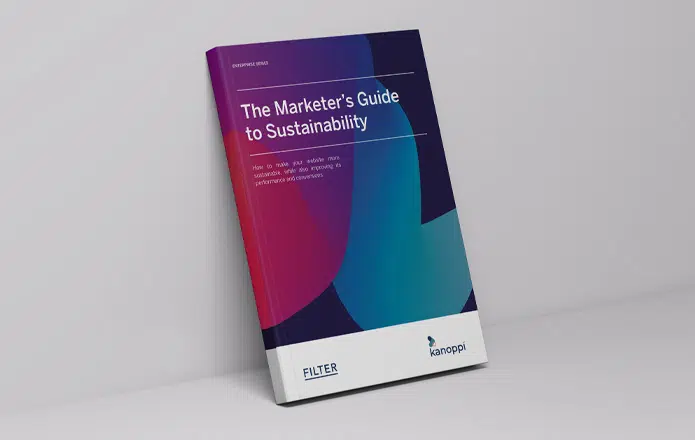
In this article, we’ll discuss why having a sustainable website can vastly improve your marketing performance.

You probably don’t often associate sustainability with revenue growth. Most people’s assumption is that more sustainable practices, whether it’s in fashion, food, or any other area, will cost more money.
But when it comes to developing and managing your website, building up your digital sustainability can improve marketing performance and can even help you convert more customers.
Our use of technology produces a huge amount of greenhouse gases, fuelling the climate change problem. A big part of this is the Internet, which would be the world’s fourth largest polluter if it were a country.
One of the main reasons the Internet has such a large carbon footprint is because it’s made up of hundreds of millions of active websites. Every single one of those websites consumes energy and produces emissions each time a user lands on a page.
Of course, not all websites and web pages are built the same. The decisions you make about how your website is hosted, designed, developed, managed, and populated with content all determine how much of a carbon footprint your individual site leaves behind.
In exploring this issue, an interesting trend has become clear. Websites that follow best practices for sustainability are typically the fastest, highest-performing websites, providing users with the best user experience (UX).
A site that doesn’t follow best practices for sustainability will usually be slow and failing to deliver the experience today’s users expect. That poor performance, in turn, harms your visitor retention and your site’s ability to generate revenue.
There are a range of factors that contribute to both the sustainability and the performance of your website. For example:
Your web hosting provider has a big influence on your site’s carbon footprint. While more progressive hosts have embraced “green hosting,” there are still plenty out there who aren’t acting responsibly, and who deliver sub-optimal performance as a result.
The power usage effectiveness (PUE) of data centres is a good indicator of whether a hosting environment is sustainable or not.
Certain design choices and themes can weigh your site down considerably, hurting its performance and consuming more energy than necessary. For example, animation is an effective way to make your content dynamic, but it’s likely to slow down your page load speeds.
Any in-house developers or other team members who work with your site’s code, they could be missing an opportunity to increase speed and lower your emissions if they aren’t following best practices for sustainable web development.
All the images and videos published on your web pages are adding to your web page weight. The heavier the weight of your pages, the more data your server has to transmit to each visitor’s browser. This consumes more energy, and it also takes longer for the page to load on your visitors’ devices.
If you’re only using one data centre to store your site and transmit all your data to your users, you’re taking a less energy-efficient approach than you could be.
There are sustainable ways to present your site to users, which we’ll discuss in more detail later in the article.
Websites are always growing and changing. You add new pages, edit content, update your designs, and tinker with your site on a daily basis. With that in mind, you should regularly perform maintenance tasks like cleaning up redundant code, removing large media files from old pages, and keep optimising as often as possible.

Download our FREE guide to digital sustainability to access key insights, created in collaboration with the industry experts behind Kanoppi.
With those common pitfalls in mind, here are some steps to take to a website that is both more environmentally-friendly and user-friendly.
Green hosting refers to the use of sustainable servers and best practices that minimise the carbon footprint of the host’s data centre. Green servers are designed to reduce energy consumption and wastage.
A by-product of working with a green hosting provider is that energy efficiency leads directly to faster website speeds and a better UX for your visitors.
Another great way to reduce your site’s carbon footprint is to use content delivery networks (CDN) to transmit data to international visitors.
CDNs are secondary servers located in other countries. They store cached copies of your site that can be transmitted to visitors who are accessing web pages from closer to the CDN’s physical location. Using a CDN reduces the amount of energy required to transmit data to those international users, and it ensures your web pages load much faster for them as well.
In September 2023, The Sustainable Web Design Community Group released the Web Sustainability Guidelines (WSG) 1.0. Much like the Web Content Accessibility Guidelines (WCAG), these are guidelines for how to design and use digital products and services in a way that puts people and the planet first.
The WSG have been put in place to help ease the digital sector’s impact on the environment. If you take them on board and begin to follow them, your website’s performance will begin to improve drastically.
It’s not realistic to expect a marketer to abandon all use of images and videos in 2023. Quite the opposite, in fact, since this kind of content is becoming increasingly popular. But there are things you can do to minimise the impact this has on the environment.
Some tips for using media files more responsibly include:
A leaner website that isn’t bloated with unnecessarily large media files will run faster for your users. There are plenty of useful tools you can use to reduce image sizes available online.
You may not have time to study the full WSG right now, and that’s understandable. But there are some simple steps you can take today to optimise your site for both sustainability and performance purposes. These include:
You can’t optimise something if you’re not measuring it. If you want to boost your digital sustainability and achieve better website performance, you need to start measuring your site’s carbon footprint.
You’ll need to capture a baseline first from your site in its current usual state, then use that baseline to proactively, consistently improve.
There are some great services and tools available that can automate most of the monitoring, measuring, and reporting for you. If you’re a WordPress user, Kanoppi is an excellent example of these.
So, we’ve established that the more energy-efficient your website is, the faster it will load and the better it will perform.
Beyond that, when you work on building your digital sustainability, it will provide you with a wealth of other benefits and advantages.
A more sustainable, high-performing website will also deliver:
If you’d like to continue learning about the relationship between digital sustainability and business growth, and the opportunities that presents, why not keep reading?
Discover more about how to optimise your website’s performance in our latest guide, The Marketer’s Guide to Sustainability.
This free eBook will help you to:
Here is a list of helpful resources to support you on your journey to becoming more sustainable.